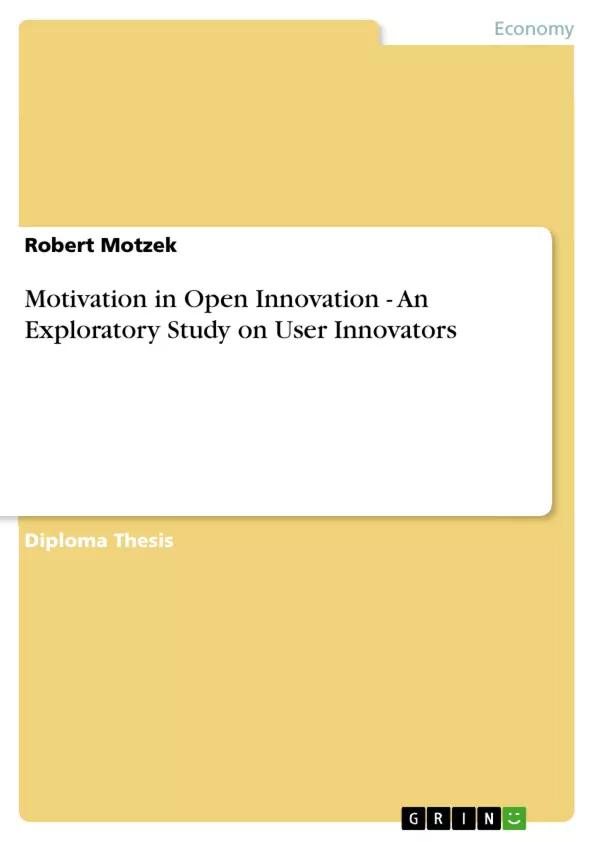Shorter product life cycles, high product flop rates and an increasing heterogeneity of consumer needs have recently put considerable pressure on the innovation activities of manufacturers. The collaboration with users in open innovation processes has been promoted as a powerful approach for companies to succeed in today’s competitive environment. However, little is known about what drives these user innovators to contribute their time and effort to the creation of new products. Most studies in this field have been restricted to open source software. Yet, a deep understanding of the motivation of user innovators represents an important first step for manufacturers to improve the nature of this type of cooperation. Besides, it enables companies to develop incentive systems that ensure the user’s continuous input for new product development.
Therefore, this report will investigate the motivational profiles of user innovators from a manufacturer’s point of view. Since lead users and tool kit users can to a very high extent be involved in the firm’s innovation process, this report will focus on the integration of those two types of users. The analysis will be supported by two exploratory case studies of Spreadshirt and Threadless, two companies which have successfully based their business models on the integration of user innovators. The report will identify the most important factors controlling user innovators’ motivation and will derive suggestions on how manufacturers can address these points in order to tap the full potential of user innovation for their new product development.
Inhaltsverzeichnis (Table of Contents)
- Introduction
- Motivation
- Structure
- From Closed to Open Innovation
- Definition of Innovation
- The Implementation of Innovation
- The Innovation Process
- Closed Innovation
- Open Innovation
- Reasons for the Emergence of Open Innovation
- Manufacturer-Based View
- User-Based View
- Integration of Open Innovation
- User Tool Kits
- Lead User Search
- Fundamentals of Motivation
- Definition of Motivation
- Classification of Motives
- Intrinsic Motives
- Extrinsic Motives
- Social Motives
- Theories of Motivation
- Content Theories
- Process Theories
- Costs in the Innovate-or-Buy Decision
- Transaction Costs
- Agency Costs
- Opportunity Costs
- Opportunity Costs of Innovating
- Opportunity Costs of Not Innovating
- Motivation in Open Source Software
- Motives of Open Source Software Programmers
- Intrinsic Motives
- Extrinsic Motives
- Social Motives
- Economics of Open Source Model by LERNER/TIROLE
- Investors and Donators Model by FRANCK/JUNGWIRTH
- Exploratory Empirical Study
- Study Design
- Sources of Data
- User Tool Kits: The Case of Spreadshirt
- Lead User Search: The Case of Threadless
- Data Generation
- Research Approach
- Outcome
- Analysis of Motives
- Intrinsic Motives
- Enjoyment
- Freedom and Control
- Learning and Intellectual Stimulation
- Summary
- Extrinsic Motives
- Own Use
- Monetary Compensation
- Job Opportunities
- Summary
- Social Motives
- Community Affiliation
- Reputation
- Feedback
- Summary
- Costs in the Innovate-or-Buy Decision
- Transaction Costs
- Agency Costs
- Opportunity Costs
- Application of Theoretical Models from Open Source Software
- Economics of Open Source Model by LERNER/TIROLE
- Immediate Benefits
- Immediate Costs
- Delayed Benefits
- Delayed Costs
- Summary
- Investors and Donators Model by FRANCK/JUNGWIRTH
- Investors
- Donators
- Discussion of Results
- Open innovation as a contemporary approach to product development.
- The role of user innovators in open innovation initiatives.
- Motivations of user innovators in the context of open innovation.
- The impact of open innovation on the traditional innovator-buyer relationship.
- Application of theoretical models from open source software to open innovation contexts.
Zielsetzung und Themenschwerpunkte (Objectives and Key Themes)
This diploma thesis explores the concept of open innovation and examines the motivations of user innovators within this framework. The study aims to analyze the factors driving user participation in open innovation initiatives, particularly focusing on user tool kits and lead user search models.
Zusammenfassung der Kapitel (Chapter Summaries)
The introduction provides a brief overview of the thesis, outlining its motivation and structure. Chapter 2 introduces the concept of open innovation, contrasting it with closed innovation models and exploring the reasons for its emergence. Chapter 3 delves into the fundamental concepts of motivation, defining it, classifying motives, and examining relevant theories of motivation. Chapter 4 analyzes the costs associated with the innovate-or-buy decision, including transaction, agency, and opportunity costs. Chapter 5 explores motivation in the context of open source software, examining the motives of programmers and reviewing relevant economic models. Chapter 6 presents an exploratory empirical study, including study design, data sources, data generation, and analysis of motives. This chapter also discusses the application of theoretical models from open source software to the study's findings.
Schlüsselwörter (Keywords)
This work focuses on the key concepts of open innovation, user innovation, motivation, user tool kits, lead user search, open source software, transaction costs, agency costs, and opportunity costs. The study examines the motives of user innovators participating in open innovation initiatives, analyzing the factors driving their engagement in these processes.
- Quote paper
- Robert Motzek (Author), 2006, Motivation in Open Innovation - An Exploratory Study on User Innovators, Munich, GRIN Verlag, https://www.grin.com/document/65537



